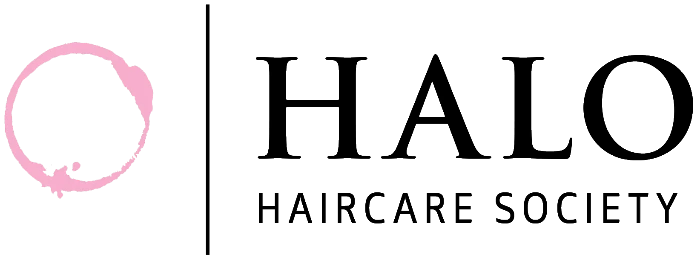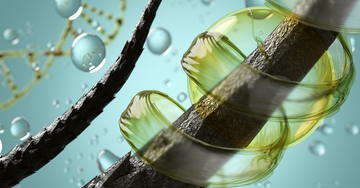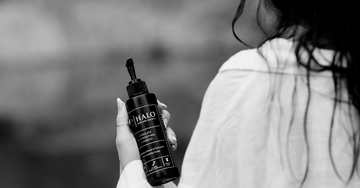Hair Changing in Perimenopause and Menopause
Hair changes during perimenopause and menopause aren’t just a cosmetic concern. They reflect complex internal shifts. Hormones influence everything from thyroid activity to blood sugar regulation, stress response, nutrient absorption, and even your scalp’s ability to grow and hold onto hair.
So how exactly does each hormonal change affect your hair, and what can you do about it? I’m going to walk you through my clinically backed, science-based tips like your in my consult room to help you navigate each underlying cause.
1. Estrogen Decline and Androgen Sensitivity
Estrogen plays a protective role in the hair cycle. It helps prolong the anagen (growth) phase and keeps testosterone in check by increasing sex hormone-binding globulin (SHBG), which binds excess androgens like DHT. As estrogen declines during perimenopause, the balance shifts. Even normal levels of testosterone can start to have a greater impact on hair follicles.
This DHT sensitivity can cause hair to become finer, thinner, or shed more easily, particularly if you're genetically inclined. For those with a predisposition to female pattern hair loss, this becomes more pronounced over time (explored further in point 9).
What helps:
- Include phytoestrogens in your diet. Flaxseeds, tempeh, tofu, lentils, and chickpeas can mildly mimic estrogen and support hormonal balance.
- Support SHBG with fibre-rich meals and plant-based proteins. Curated diet plans are available through a Trichology consult.
- Use topical plant-based DHT blockers such as pumpkin seed extract, rosemary, saw palmetto, and stinging nettle. They may help reduce DHT activity directly at the scalp. You’ll find them in our Stimulate and Strengthen Shampoo and Rescued By range.
2. Progesterone Drops and Inflammation
Progesterone helps regulate estrogen and has a calming, anti-inflammatory effect throughout the body. When it falls, you may develop symptoms of estrogen dominance, even if estrogen is also declining. This can increase overall inflammation.
On the scalp, this might show up as sensitivity, itching, oiliness, or flare-ups of conditions like seborrheic dermatitis.
What helps:
- Support inflammation through diet. Include omega-3 rich seeds (chia, flax, hemp), turmeric, and dark leafy greens.
- Use topical anti-inflammatory botanicals like beta-glucan, saccharide isomerate, liquorice extract, red clover, and green tea extract. You’ll find these in our Tricho-barrier Shampoo and Revitalise Serum.
- Avoid excessive mechanical stress on the scalp such as tight hairstyles or harsh brushing. We recommend our Boar Bristle Brush for gentle exfoliation and stress reduction.
3. Increased Cortisol and Chronic Stress
With lower estrogen and progesterone, the nervous system becomes more reactive to stress. This raises cortisol, a hormone known to disrupt the hair cycle by pushing follicles into the telogen (resting) phase too soon. This leads to telogen effluvium, a type of temporary shedding.
Cortisol also constricts blood vessels, reducing oxygen and nutrient delivery to the follicles. Long-term stress can deplete magnesium, zinc, and B vitamins, all of which are essential for healthy hair growth.
What helps:
- Add plant-based vasodilators like beetroot, cayenne pepper, raw cacao, and dark berries to your meals.
- Move your body daily with walking, yoga, pilates, or rebounding to regulate cortisol without over-stressing the adrenals.
- Build stress resilience through journaling, meditation, and regular sleep routines.
- Use topical plant-based vasodilators to improve blood flow and oxygenation to the follicles. You’ll find these in our Stimulate and Strengthen and Rescued By ranges.
4. Thyroid Function and Metabolism
Estrogen supports thyroid hormone activity and conversion. As estrogen drops, active T3 levels may fall. T3 is the form of thyroid hormone that regulates metabolism, skin renewal, and hair growth. Many women experience subtle thyroid dysfunction during perimenopause, even without a formal diagnosis. This often contributes to dry, thinning hair, slowed growth, and coarser texture.
What helps:
- Prioritise nutrients for thyroid function such as iodine (sea vegetables like nori and wakame), selenium (Brazil nuts), and zinc (pumpkin seeds, tahini, legumes).
- Follow a whole-food, anti-inflammatory diet with a low glycaemic load to reduce stress on the thyroid.
- For scalp dryness and fragility, use topical ceramides, beta-glucan, and hydrating actives to support the scalp barrier. You’ll find these in our Hydrated Halo Shampoo, Reinforcement Treatment, and Revitalise Serum for the scalp, and Hydro Repair Mask and Silk Elixir for your lengths.
5. Blood Sugar and Insulin Resistance
Estrogen helps maintain insulin sensitivity. As levels decline, blood sugar regulation can become harder. This increases systemic inflammation and can stimulate excess androgen production from the adrenal glands. The result is often hair thinning patterns similar to PCOS, especially around the temples or crown.
What helps:
- Balance blood sugar with plant-based meals high in protein and fibre. Lentils, beans, whole grains, nuts, seeds, and vegetables are excellent choices.
- Avoid frequent snacking on refined carbohydrates. Focus on 3 to 4 balanced meals a day.
- Try cinnamon, bitter melon, fenugreek, and apple cider vinegar to support blood sugar balance.
- Rescued By contains plant-based vasodilators and anti-inflammatory ingredients to improve scalp circulation and follicle health.
6. Nutrient Absorption and Gut Health
Digestive function often slows during midlife. This can lead to lower stomach acid, changes in gut bacteria, and can reduce absorption of key hair nutrients like iron, zinc, B12, biotin, magnesium, and essential fatty acids. These nutrients are all critical for healthy hair growth.
What helps:
- Eat a wide variety of plants. Aim for at least 30 different plant foods each week to support gut microbiome diversity.
- Combine iron-rich foods (lentils, tofu, quinoa, spinach) with vitamin C sources (citrus, capsicum, kiwi, parsley) to enhance absorption.
- Avoid drinking tea or coffee with meals as they reduce mineral absorption.
- Halo haircare mimics your hair’s natural structure and supports the skin barrier to promote hair health from the outside.
7. Poor Sleep and Melatonin Disruption
Both estrogen and progesterone play a role in sleep quality. When these hormones drop, melatonin production is affected. This can make it harder to fall asleep and stay asleep. Poor sleep reduces the release of growth hormone, which supports cell repair, including in the scalp.
What helps:
- Support melatonin naturally with tart cherry juice, pistachios, and magnesium-rich foods like leafy greens and pumpkin seeds.
- Consider Ashwagandha as a supplement or sleep drink to support your stress response and encourage deeper, more restorative sleep.
- Keep screens off at least an hour before bed and get morning sunlight to help reset your circadian rhythm.
- Use a silk pillowcase or turban to reduce friction on thinning hair and regulate scalp temperature overnight.
8. Reduced Circulation to the Scalp
Hormonal changes, inflammation, stress, and reduced movement can all lead to diminished blood flow to the scalp. When circulation slows, nutrient and oxygen delivery to the follicles declines. Detoxification can also become impaired, leading to a poorer follicle environment.
What helps:
- Massage your scalp daily or use a scalp brush to stimulate blood flow.
- Use ingredients that support vasodilation such as ginkgo biloba, rosemary oil, peppermint oil, or caffeine which you'll find as a core ingredients in our scalp care products.
- Incorporate regular exercise to improve overall circulation, including to the scalp.
9. Genetic Predisposition to Female Pattern Hair Loss
As discussed in point 1, declining estrogen increases the impact of DHT. For those with a genetic predisposition to androgenetic alopecia, this becomes more apparent during perimenopause and menopause.
This type of hair loss typically shows as diffuse thinning over the crown and a widening part line, while the frontal hairline remains mostly intact.
What helps:
- Use topical DHT blockers like pumpkin seed oil, saw palmetto, green tea, rosemary, and caffeine-based formulas.
- Consider clinically tested tools such as Low-Level Laser Therapy (LLLT) to support hair density and slow progression.
- Combine targeted topical care with internal hormone-balancing foods and consistent scalp health routines to support follicle resilience.
How do I sum up your hormones and hair health
Hair loss and changes during perimenopause and menopause are rarely caused by a single factor. Multiple systems are affected at once. Hormones, thyroid health, gut function, stress, inflammation, genetics, and circulation all play interconnected roles.
The good news is that there are real, evidence-based ways to support your hair, both internally and topically.
The key is consistency and a whole-body approach:
- Nourish your body with diverse, anti-inflammatory plant foods
- Regulate stress with movement, mindfulness, and rest
- Use targeted scalp actives that support the skin barrier, circulation, and hormonal balance
- Honour your changing body by listening to its needs and responding with care, not fear
Not sure where to start, book a Trichology consult for a personalised routine designed for you.




